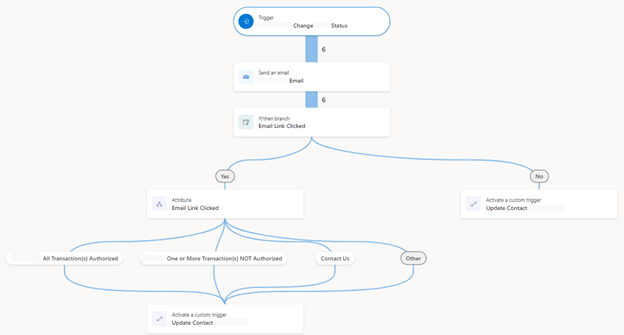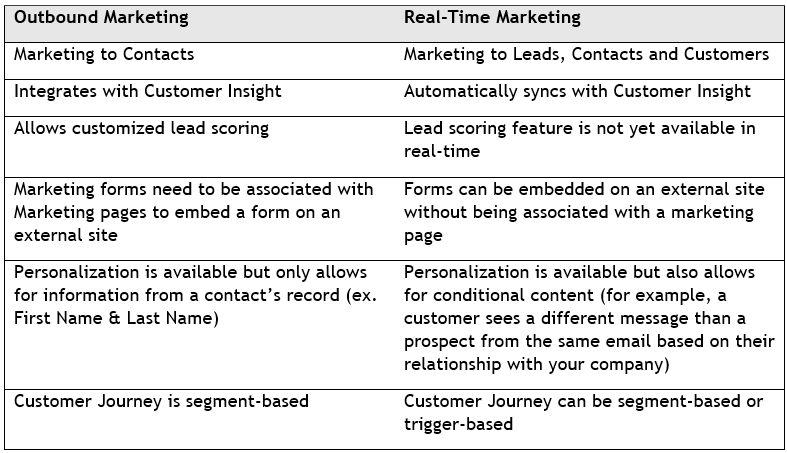Microsoft Dynamics: Shifting From Outbound to Real-Time
Microsoft Dynamics: Shifting From Outbound to Real-Time
It’s finally here—the moment that Dynamics Marketing users have been anticipating. Microsoft recently announced the imminent deprecation of outbound marketing within the next year and the continued support for real-time marketing. In case you missed the announcement, it’s posted all over the Dynamics 365 Marketing documentation.
 Source: Real-time marketing overview
Source: Real-time marketing overview
What Does the Shift to Real-Time Marketing Mean for You?
If you just started using Dynamics 365 Marketing, you won’t notice significant—if any—changes as you’ll only see the real-time marketing application. On the other hand, if you have been using outbound marketing, my team is here to help guide you through the transition to real-time, and this article gives you a starting point.
Why Were There Two Applications in the First Place?
Outbound marketing has been around for quite some time. You may have guessed by the name of the application that it was created to allow for bulk email marketing delivery.
Think of this tool as being used for sending drip nurtures and batch-and-blast emails to contacts in specific segments. What outbound marketing lacked was the ability to easily follow-up with the audience once an action occurred or all the emails were sent from that one customer journey. Unless you had the skills to create a Power Automate flow to listen for activity, there was no way to guide your audience down a more customized path. Your two options would be to either send them through another unguided customer journey or to your sales team.
What makes real-time any different?
In addition to the segment-based journeys you may be familiar with, real-time customer journeys allow you to automatically respond to a person’s response by giving you the option to create trigger-based journeys that guide your prospect down a customized path based on their actions.
For example, you can set up the journey to automatically send an autoresponder email or even a confirmation text to the person’s phone after they click through your email and submit a form. This allows continuous nurturing until that prospect is likely to purchase your product. That’s where the sales team can come in and continue to follow up with any information your prospect requests.
Let’s take a look at what other differences there are between the two applications.
Outbound Marketing vs. Real-Time Marketing
The chart below highlights the features of outbound marketing and real-time marketing and shows some of the ways they differ.
The table above shows only some of the features that are different between outbound marketing and real-time marketing. To see a full list, read Move from outbound to real-time marketing.
To further illustrate the differences, check out the examples below.
Outbound marketing customer journey 
Real-time marketing customer journey

What Do Current Outbound Marketing Users Need to Know?
If you’ve ever participated in a migration project where you move from one marketing platform to another, you probably know that the process can be labor-intensive. However, it doesn’t have to feel intimidating. With proper planning and organization, you can turn the transition to real-time marketing into a step-by-step project. And if you need support, BDO Digital can help.
Here are a few things I recommend to help your transition go smoothly:
STEP 1. PLAN AHEAD
Decide when your organization should fully transition to real-time marketing. Having a deadline to complete the transition can help you and your team decide which steps are top priorities, when each task should be completed, and who to assign to complete each task.
Above all, as you develop these timelines, don’t forget to provide time for rebuilding, reprocessing, and testing.
STEP 2. DOCUMENT
Documenting all assets including emails, forms, and Power Automate flows, among others, helps your team inventory what is still relevant and what items you don’t need to bring to the new platform.
A good rule of thumb is that if the customer journey in outbound marketing was a ‘one-and-done’ program, you most likely no longer need it. This also applies to emails, forms and other assets that are in outbound marketing and Power Automate.
The table below lists common assets that you probably need to migrate.

Now that you’ve created your inventory, it’s a good idea to have assignees document the steps needed to complete each task. For example, if a Power Automate flow needs to be rebuilt, create a technical specification document so you and your solution architects have a roadmap when it’s time to rebuild your flow.
STEP 3. START THE TRANSITION
Once you’ve set a cutover date and documented everything that needs to be moved from outbound marketing to real-time marketing, it’s time to begin the transition.
It’s a good idea to schedule weekly check-ins with your team to keep track of what’s in progress, what’s complete and if anyone needs help.
Looking Ahead as You Shift from Outbound to Real-Time Marketing
Microsoft’s announcement means that shifting from outbound to real-time is imperative moving forward. It’s no longer just a good idea for marketers, but a must. However, the transition doesn’t have to be overwhelming. By following this process, you can effectively make the transition to real-time marketing so it’s ready for your team.
BDO Digital’s team of marketing professionals is dedicated to helping clients with platform migration, including shifting from outbound to real-time marketing. To learn some of the ways we can support your team, contact us today!


SHARE